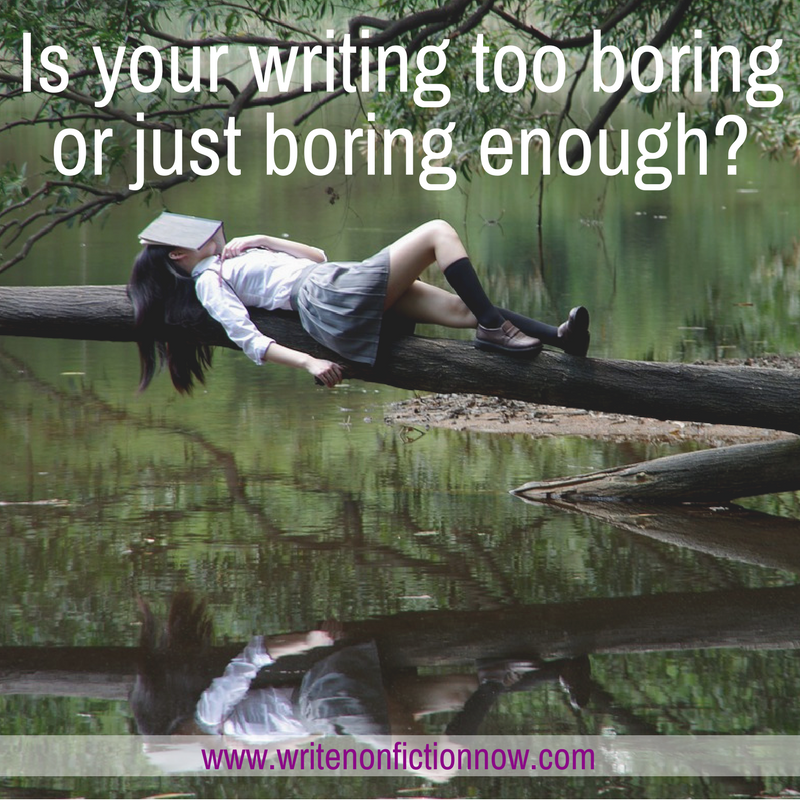Wednesday, March 28, 2018

Do you worry about your writing being too boring for your readers? Maybe it’s time to stop worrying about that. In this guest post, book editor
C.K. Bush (
@theladyck) explains the value of boring writing—or having just the right amount of boring in your work.
Everyone wants their writing to stand out. You don’t want to write just another memoir of moving to New York City; you want to write a unique coming-of-age story. You don’t want to write another profile of a literary figure; you want to write a witty, memorable one.
Having high aspirations is good. Without ambition, most writers wouldn’t be driven to write. Yet, there is a limit to how unique you should try to be when trying to stand out.
You don’t want to be a boring writer, but you do want to make sure you have the right level of boringness in your work so readers don’t get distracted from the important thing—the content.
So, how do you get “just the right” amount of pizzazz in a piece of writing so you don’t stand out in the total wrong way? Here are a few tips.
You do want to make sure you have the right level of boringness in your work.Click To Tweet
Don’t try too hard.
If you are working to make your piece unique, you are at high risk of trying too hard. Nothing alienates readers faster than cringe-worthy writing.
If it occurs to you that starting your piece with an anecdote will draw readers in, don’t labor to make it a five-page, richly descriptive narrative masterpiece if it doesn’t come to you naturally. A paragraph might suffice. A belabored narrative opening might do the opposite of what you’re intending and instead drive readers away.
The same goes for humor or trying to be millennial-tech-friendly—if it doesn’t come naturally, it’s better to hold off until it does.
Don’t make things up.
This tip seems like it should be a no-brainer, but you’d be surprised by how many writers resort to stretching the truth to make a story or fact more exciting. While artistic license is sometimes acceptable, especially with memoir, don’t give in to temptation to embellish factual writing or reporting.
If your topic by necessity needs to be exciting, and you just can’t get there, it’s a sign that you might need to do more research or find a new angle. And don’t forget—some topics are meant to be a bit more low-stakes. If you are writing a how-to book, no one is expecting breathtaking narrative.
Work on your execution.
Even the narrowest of subjects can lead to a great book if the form is done cleanly. A well-executed book for its genre can be satisfying for this reason alone. Resist having unwieldy chapters that include every anecdote. Avoid adding excessive layers on top of your narrative, like numerous epigraph quotes or endless interludes between the real chapters.
And follow traditional conventions of good writing. Chapters shouldn’t all begin with ‘This chapter is about…”; the book should have a throughline or thesis that holds it all together.
These basic writing practices are meant to help you transform workmanlike writing into something enjoyable to read—in other words, something that isn’t boring. By focusing on narrative technique and sound structure in the first place, you are already avoiding being boring. Sometimes, simple is the best and most desirable.
Follow traditional conventions of good writing.Click To Tweet
Be yourself.
Hunter S. Thompson wrote some pretty crazy nonfiction; his freewheeling style redefined what was possible in the genre of creative nonfiction. He also had it in his will that his ashes should be shot out of a cannon.
What I’m saying here is that Thompson’s unique style came out of his natural way of being. He wasn’t trying to be anyone other than Hunter S. Thompson. The same goes for any nonfiction writer, even if you’re just writing about being vegan rather than embarking on drug-riddled gonzo journalism.
If you write what you actually think and actually would say, and not what you think will be the most entertaining or most like a writer you admire, your writing will invariably be better because it is more grounded and genuine. Readers can smell disingenuousness from miles away.
Readers can smell disingenuousness from miles away.Click To Tweet
The best nonfiction writing stands out for only two reasons: it’s well-crafted, and it’s conveying interesting information. Focus on these two things, and your work will stand out without adding on any other bells and whistles. Sometimes it’s better to be the just right amount of boring.
How do you find the balance between too boring and not boring enough? Tell me in a comment below.About the Author
 C.K. Bush
C.K. Bush is a nonfiction editor and writer. She lives in New York City.
Photo copyright: ivxintong / Pixabay.com
The post
Too Boring, Not Boring Enough: Getting the Pizzazz Factor Right in Your Writing appeared first on
Write Nonfiction NOW!.
Nina Amir, the bestselling author of How to Blog a Book and The Author Training Manual, is a speaker, a blogger, and an author, book, blog-to-book, and high-performance coach. Known as the Inspiration to Creation Coach, she helps creative people combine their passion and purpose so they move from idea to inspired action and positively and meaningfully impact the world as writers, bloggers, authorpreneurs, and blogpreneurs. Some of Nina’s clients have sold 300,000+ copies of their books, landed deals with major publishing houses and created thriving businesses around their books. She is the founder of National Nonfiction Writing Month, National Book Blogging Month, and the Nonfiction Writers’ University. As a hybrid author she has published 19 books and had as many as four books on the Amazon Top 100 list at the same time. Her most recent book is called Creative Visualization for Writers, and tomorrow her 19th book will be released, The Write Nonfiction NOW! Guide to Creativity and Flow. Find all her books at booksbyninaamir.com or find out more about her at ninaamir.com.